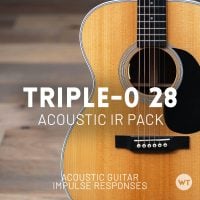Description
IMPORTANT NOTES
1. CROSS PLATFORM: These .WAV impulse responses can be used in any hardware or application that supports IR’s. This includes products by Line 6 (Helix, HX Stomp, HX Effects, etc), Kemper, Axe-FX, etc.
2. EXPERIMENT: We’ve included multiple options in this IR pack (more details below). The best idea is just to start experimenting and find the IR or combinations of IR’s that sound the best.
QUICK START
The first step is to determine what sample rate and length you need to use. Refer to the user manual of the hardware or software you intend to use the IR’s with to determine the correct file type. These IRs come in the following options:
- 44.1 kHz, 200ms and 500ms
- 48 kHz, 200ms and 500ms (Line 6 Hardware – use 500ms)
- 96 kHz, 200ms and 500ms (IRIDIUM – use 500ms)
- We’ve also included a ‘Line 6’ and ‘Iridium’ folder. These are the 48k 500ms and 96k 500ms options respectively.
Next you’ll want to experiment with the different mic options. Our recommendation is to start with the ‘mic combo’ options. We have found that if you intend to run two IR’s in stereo, the best results come from using two different single mic IR’s. See the ‘Mic’ section below for more details.
THE CAB/SPEAKERS

These IR’s were created from an ’Tyler 10/12 Cabinet loaded with a 12” UK Celestion Greenback (G12H30) speaker and a 10” Eminence Ragin Cajun speaker.
This unique combination of a twelve inch speaker (which is commonly paired with British amps) and a ten inch speaker (which is commonly paired with American amps) gives a very unique frequency response, and pairs well with a wide variety of amp types. You get warmth, punch, and chime – all at the same time.
THE MICROPHONES

To create this IR pack we used a variety of microphones, including a Slate VMS ML2, which we used to recreate emulations of classic microphones
In the file names you’ll see microphone codes. Here is what they mean:
- ‘7b’ – This is the Shure SM7b. It’s a dynamic microphone that sounds a bit more focussed than an SM57 with a slightly different midrange character. Pairs well with ribbon mics.
- ‘160’ This is the Beyerdynamic M160. It’s a ribbon mic that is a popular alternative to the Royer 121. It’s punchy and offers the warmth of a classic ribbon mic but with the punch and midrange often found in dynamic mics. Pairs well with dynamic mics.
- ‘121’ – This is a Royer 121. The 121 is a classic ribbon mic used on countless hit records. Pairs well with dynamic mics.
- ‘SR25’ – This is the Earthworks SR25. A small diaphragm condenser that works extremely well on a wide variety of instruments, and surprisingly well on guitar cabs. It’s very articulate and bright without being harsh, but has a ton of warmth and character as well. We love pairing this with the 160. Pairs well with ribbon mics.
- ’57’ – This one is actually an emulation of a vintage Shure SM57 from the Slate ML2. To our ears it’s a slightly smoother/warmer version of a modern 57. Pairs well with ribbon mics. We have a real Shure SM57, but we feel the Slate emulation of the vintage 57 sounds better :).
- ‘M222’ – This is an emulation of a Schoepps M222, a rare vintage tube microphone. This one is the warmest of the bunch – it works well to add warmth and character to brighter amps, and pairs well with dynamic microphones.
IR’s: COMBO’s vs INDIVIDUAL SPEAKER IR’s
Since this cabinet is so unique, we chose to give you a wide variety of options for IR’s.
Combo (both speaker) IR’s: These IR’s were made using two mic’s – one on each speaker. We suggest starting with these options. We like to pair the ribbon mics with the dynamic/condensor mics, which gives the perfect balance of warmth and punch/brightness.
Individual speaker IR’s. These IR’s were made with individual microphones on each speaker. They are labeled ‘GB’ for the 12in. Greenback and ‘RC’ for the 10in. Ragin Cajun. You may find that you really like the sound of a specific mic on a specific speaker, but if you have the ability to run two IR’s in stereo, these individual IR’s will give you a lot of different tonal options.
INCLUDED DOWNLOADS
The IR’s are available in WAV formate in four different sample rates: 44.1 kHz, 48 kHz, and 96 kHz (all at 24 bit) and at both 200ms and 500ms. This ensures these IR’s are compatible with a wide variety of hardware and software options.











Reviews
There are no reviews yet.